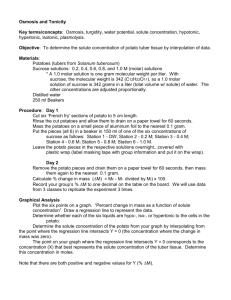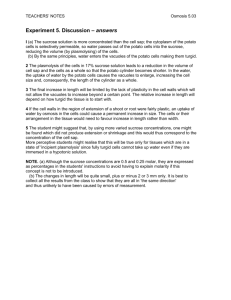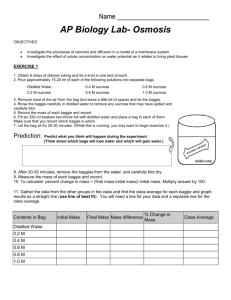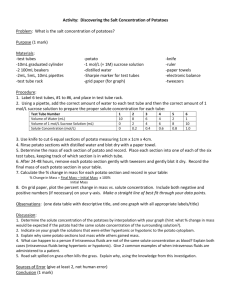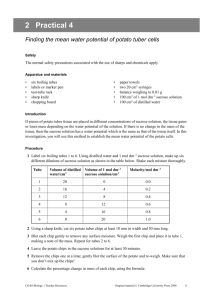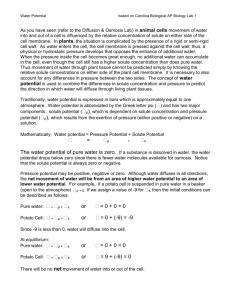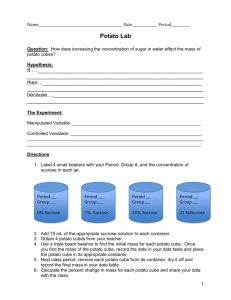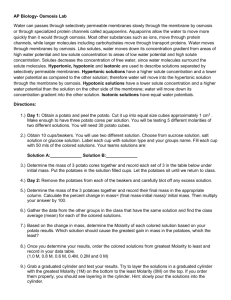solutions molecules
advertisement
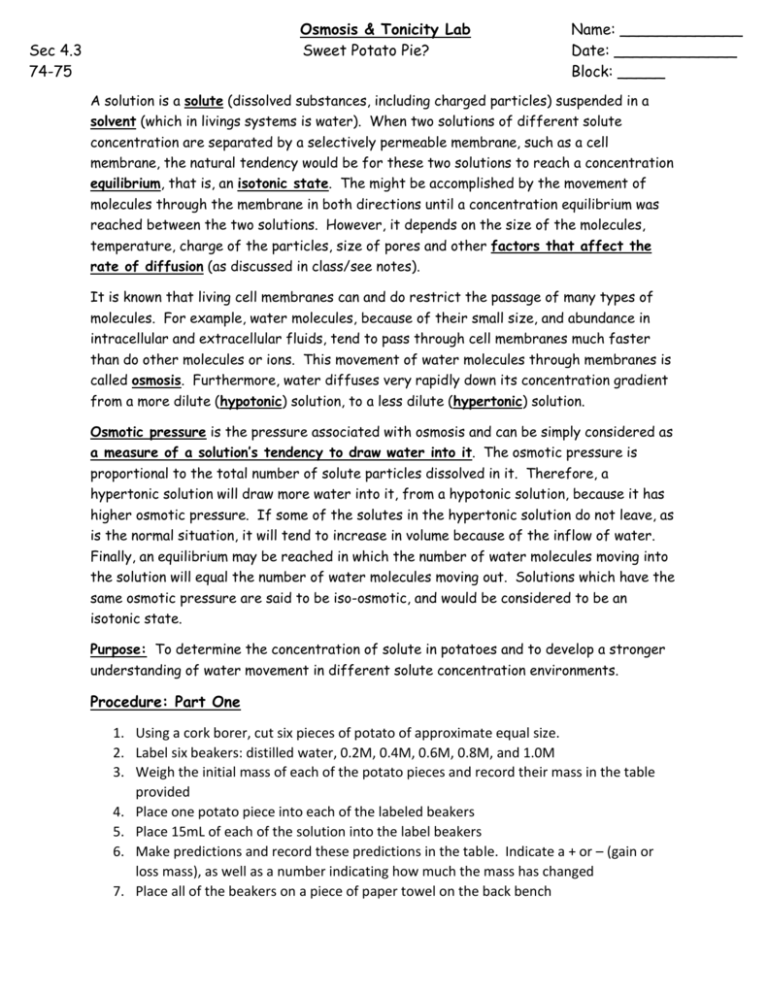
Sec 4.3 74-75 P7 Osmosis & Tonicity Lab Sweet Potato Pie? Name: _____________ Date: _____________ Block: _____ A solution is a solute (dissolved substances, including charged particles) suspended in a solvent (which in livings systems is water). When two solutions of different solute concentration are separated by a selectively permeable membrane, such as a cell membrane, the natural tendency would be for these two solutions to reach a concentration equilibrium, that is, an isotonic state. The might be accomplished by the movement of molecules through the membrane in both directions until a concentration equilibrium was reached between the two solutions. However, it depends on the size of the molecules, temperature, charge of the particles, size of pores and other factors that affect the rate of diffusion (as discussed in class/see notes). It is known that living cell membranes can and do restrict the passage of many types of molecules. For example, water molecules, because of their small size, and abundance in intracellular and extracellular fluids, tend to pass through cell membranes much faster than do other molecules or ions. This movement of water molecules through membranes is called osmosis. Furthermore, water diffuses very rapidly down its concentration gradient from a more dilute (hypotonic) solution, to a less dilute (hypertonic) solution. Osmotic pressure is the pressure associated with osmosis and can be simply considered as a measure of a solution’s tendency to draw water into it. The osmotic pressure is proportional to the total number of solute particles dissolved in it. Therefore, a hypertonic solution will draw more water into it, from a hypotonic solution, because it has higher osmotic pressure. If some of the solutes in the hypertonic solution do not leave, as is the normal situation, it will tend to increase in volume because of the inflow of water. Finally, an equilibrium may be reached in which the number of water molecules moving into the solution will equal the number of water molecules moving out. Solutions which have the same osmotic pressure are said to be iso-osmotic, and would be considered to be an isotonic state. Purpose: To determine the concentration of solute in potatoes and to develop a stronger understanding of water movement in different solute concentration environments. Procedure: Part One 1. Using a cork borer, cut six pieces of potato of approximate equal size. 2. Label six beakers: distilled water, 0.2M, 0.4M, 0.6M, 0.8M, and 1.0M 3. Weigh the initial mass of each of the potato pieces and record their mass in the table provided 4. Place one potato piece into each of the labeled beakers 5. Place 15mL of each of the solution into the label beakers 6. Make predictions and record these predictions in the table. Indicate a + or – (gain or loss mass), as well as a number indicating how much the mass has changed 7. Place all of the beakers on a piece of paper towel on the back bench Procedure: Part Two change in mass initial mass x 100 = % Change Mass 1. Carefully remove each potato piece, dap off and solution. 2. Weigh each potato piece, one at a time, and record the final mass 3. Calculate the change in mass and record the values (final-initial) 4. Calculate the percent change in mass and record the values 5. Collect the class data and record the values 6. Calculate the average percent mass change according to our class’ data 7. Graph Both your individual group data, as well as the class data 8. Draw a smooth line that connects the data points 9. Create a legend on the side of the graph that indicates which line is your group compared to the class data Table One: Potato Pieces (Individual Data) Contents in Beaker Initial Mass Final Mass Predicted Mass Difference Calculated Mass Difference Percent Change in Mass Distilled water 0.2M sucrose 0.4M sucrose 0.6M sucrose 0.8M sucrose 1.0M sucrose Table Two: Potato Pieces (Class Data) Contents G1 in Beaker Distilled water 0.2M sucrose 0.4M sucrose 0.6M sucrose 0.8M sucrose 1.0M sucrose G2 G3 G4 G5 G6 G7 Total Average Discussion Questions: 1. What was done to try and ensure that this was a controlled experiment? ____________________________________________________________________________ ____________________________________________________________________________ ____ 2. What were some variables that were difficult to control. Explain the significance of this. ______________________________________________________________________________ ______________________________________________________________________________ 3. What was the independent variable? Dependent variable in this lab? Remember the x-axis on the graph is the independent and the y-axis is the dependent variable. ______________________________________________________________________________ ______________________________________________________________________________ 4. In terms of tonicity, explain why some potato sections increased in mass, why some decreased in mass, and why some changed very little. ______________________________________________________________________________ ______________________________________________________________________________ ______________________________________________________________________________ ______________________________________________________________________________ 5. At what concentration point is the potato and the sucrose solution isotonic? Explain. What can you conclude about the solute concentration of the potato? ______________________________________________________________________________ ______________________________________________________________________________ 6. If potato cells were suspended in 1.0M of sodium chloride solution instead of sucrose, what would you expect to happen to the mass of the potato cells? Explain. ______________________________________________________________________________ ______________________________________________________________________________ ______________________________________________________________________________ 7. Explain how salt can be used as a slug killer. ______________________________________________________________________________ ______________________________________________________________________________ ______________________________________________________________________________ Conclusion: -Write in a passive/neutral tone (AVOID “I”, “My”, “We” etc) -Summarize the purpose & main ideas demonstrated in this lab. -Discuss sources of error, their significance and means to fix these ______________________________________________________________________________ ______________________________________________________________________________ ______________________________________________________________________________ ______________________________________________________________________________ ______________________________________________________________________________ ______________________________________________________________________________ ____________________________________________________________________________ ____________________________________________________________________________ ____________________________________________________________________________ ____________________________________________________________________________

